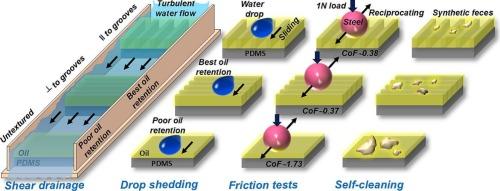用于卫生应用的微槽自清洁光滑表面的定向保油和磨损性能
IF 4.3
2区 工程技术
Q2 ENGINEERING, CHEMICAL
引用次数: 0
摘要
注入润滑油的光滑表面容易受到外部流体(水、空气)剪切流的影响。本研究报道了模拟马桶冲洗湍流(Re ~ 6129)水流对香蕉叶模板制备的微槽聚二甲基硅氧烷复制品中硅油潴留和粪便自清洁性能的影响。在与凹槽平行(∥)、垂直(⊥)方向和无纹理表面上,20 min的恒定湍流中,油潴留量分别为28 %、42 %和24 %。水流后,水的滑脱角(SAs)为 ~ ,对于⊥流为9°,对于∥流为~ 14°,显示了光滑的保留。另一方面,没有纹理的表面失去了光滑性。此外,200个滑动水滴下空气中的油潴留显示出向沟槽>;∥向沟槽 >; 无纹理的趋势。此外,油涂布microgrooves 显示较小的摩擦系数0.35±0.009 (⊥凹槽),0.38 ± 0.003(∥凹槽),相比untextured表面(1.73 ±0.198 ),与钢球磨损时使用1 N负荷,在往复运动40 mm⋅年代−1滑动速度和10 mm滑动的距离。经过30个连续的合成粪便沉积周期后,与对凹槽和无纹理表面的滑模相比,对凹槽的滑模的残留量是最低的。显然,凹槽的⊥和∥方向之间的权衡可以在卫生和污水系统中提供最佳的保油和自清洁性能。本文章由计算机程序翻译,如有差异,请以英文原文为准。

Directional oil retention and abrasion properties of microgrooved self-cleaning slippery surfaces for sanitation applications
Lubricant infused slippery surfaces are vulnerable to external shear flow of fluids (water, air). This study reports the influence of mimicked commode flushing turbulent (Re ∼ 6129) water flow on the silicone oil retention and feces self-cleaning properties in microgrooved polydimethylsiloxane replicas fabricated using banana leaf template. Oil retention amounts are 28 %, 42 %, and 24 % for 20 min of constant turbulent flow in parallel (∥), perpendicular (⊥) directions to grooves and on untextured surfaces, respectively. Post flow, water slide-off angles (SAs) are ∼ 9° for ⊥ flow, ∼14° for ∥ flow, showcasing the retention of slipperiness. On the other hand, untextured surfaces lost their slipperiness. Also, oil retention in air under 200 gliding water droplets shows trend of ⊥ to grooves > ∥ to grooves > untextured. Furthermore, oil coated microgrooves displayed smaller coefficient of friction of 0.35 ± 0.009 (⊥ to grooves), 0.38 ± 0.003 (∥ to grooves), as compared to untextured surfaces (1.73 ± 0.198), when abraded with a steel ball in reciprocating motion using 1 N load, 40 mm⋅s−1 sliding speed and 10 mm sliding distance. After 30 consecutive cycles of synthetic feces deposition, its residual amount is lowest when sliding on ∥ to grooves as compared to ⊥ to grooves and untextured surfaces. Clearly, a trade-off between ⊥ and ∥ directions to grooves can provide optimal oil retention and self-cleaning properties in sanitation and sewage systems.
求助全文
通过发布文献求助,成功后即可免费获取论文全文。
去求助
来源期刊

Chemical Engineering Science
工程技术-工程:化工
CiteScore
7.50
自引率
8.50%
发文量
1025
审稿时长
50 days
期刊介绍:
Chemical engineering enables the transformation of natural resources and energy into useful products for society. It draws on and applies natural sciences, mathematics and economics, and has developed fundamental engineering science that underpins the discipline.
Chemical Engineering Science (CES) has been publishing papers on the fundamentals of chemical engineering since 1951. CES is the platform where the most significant advances in the discipline have ever since been published. Chemical Engineering Science has accompanied and sustained chemical engineering through its development into the vibrant and broad scientific discipline it is today.
 求助内容:
求助内容: 应助结果提醒方式:
应助结果提醒方式:


